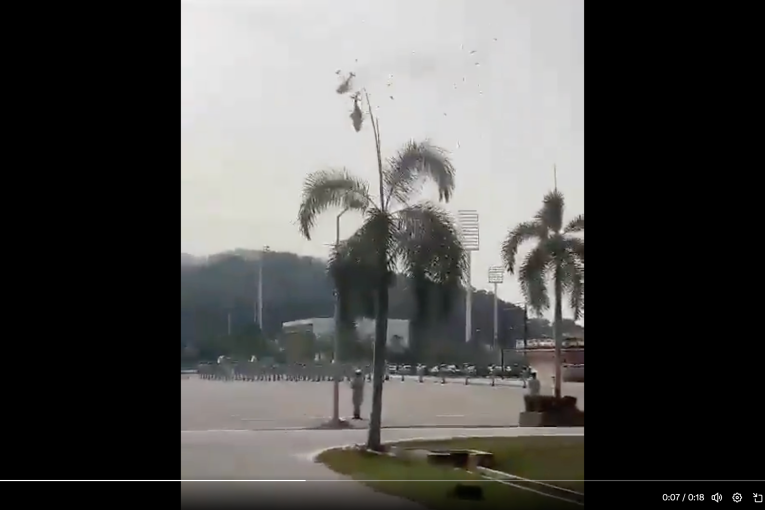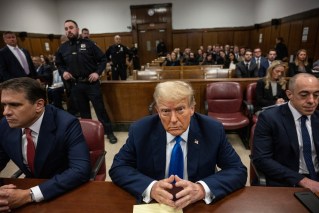Satellites blown to smithereens: Trump reboots US Star Wars program


Donald Trump is pushing for an army of space cadets to do battle with America's enemies. Photo: Getty
That’s one small step from the Oval office, one giant laser blast for mankind if US President Donald Trump gets the full-blown space army he’s angling for.
On Thursday, Mr Trump revived Space Command, the Reagan-era initiative that famously aspired to shoot down nuclear missiles using lasers and particle beam weapons.
Reagan was mocked by his rivals: they re-named his space plan “Star Wars” – making it sexier in the public mind than perhaps anyone ever intended.
This time it’s not a joke
Mr Trump’s announcement is being taken more seriously, because Russia, China and India have emerged as genuine off-planet threats to US satellite and military guidance systems.
But the resurrection of Space Command is also a stepping-stone to the president’s dream of establishing a Space Force, with real soldiers – a move that requires the support of Congress.
Regardless, Mr Trump talked about Space Force as if it were a done deal.
“The Space Force will organise, train and equip warriors to support Spacecom’s mission,” he said during a Rose Garden ceremony in which Space Command’s new flag – an eagle flying above the Earth – was shown off to the cameras.
“This is a landmark day, one that recognises the centrality of space to America’s security and defence,” he said.
Martians aren’t the enemy
“Those who wish to harm the United States, to seek to challenge us on the ultimate high ground of space, it’s going to be a whole different ballgame.”
Space Command is a relatively modest affair – with a reported 287 personnel under the command of Air Force General John Raymond.
“We no longer have the luxury of treating space superiority as a given,” General Raymond told reporters at the Pentagon.
The first strike from Space Command comes in the form of a dull website, where it lays out its mission:
- Deter Aggression/Conflict: USSPACECOM strengthens our national deterrence through the provision of space warfighting options that preserve U.S. and allied competitive advantage, promote security and stability.
- Defend U.S./Allied Interests: If deterrence fails, USSPACECOM, in coordination with allied and joint force commanders and inter-agency partners, will lead the protection and defence of our combined interests in the space domain.
- Deliver Space Combat Power: USSPACECOM is committed to preserving and expanding space combat power to enable joint and combined force success.
- Develop Ready and Lethal Joint Warfighters: USSPACECOM will improve the development of joint space operations forces and capabilities to enhance space warfighting readiness and lethality while accelerating the integration of space capabilities into other warfighting forces.
This is all pretty vague. But the threats are not – and for a comprehensive overview go here.
While, there’s been reckless behaviour from all sides, it can be argued the US has brought an orbital arms race on itself.
For some years, China and Russia attempted to push the US into a treaty banning space-weapons testing.
In 2007, China blew up one of its own satellites in an unannounced test that caught the George Bush administration by surprise.
Defence strategy experts, in a report in the New York Times, suggested the test was a “shot across the bow” and a classic Cold War negotiating technique, designed to push the US into a treaty.

Shooting down satellites with missiles is becoming old hat. Lasers are quicker and less cumbersome. Photo: Getty
In 2013, China sent up another satellite-killer that did a fly-by of America’s key national security and spy satellites. The US responded by investing billions of dollars in protective measures.
Coincidentally, in 2013, debris from China’s 2007 blown-up satellite struck and incapacitated a Russian scientific satellite – demonstrating that once you turn an orbiting object into thousands of pieces of shrapnel, they just keep travelling around the Earth at devastating speed.
China – which is now thought to have killer-laser technology, which is less cumbersome and sneakier than missiles – has recently designated space as a military domain. NATO is due to do so in December.
In March, India joined the space “super league” by shooting down one of its own satellites with a modified ballistic missile, according to Prime Minister Narendra Modi.
Caught out, again, NASA was horrified, because debris from the strike threatened the International Space Station and its residents.
“That is a terrible, terrible thing to create an event that sends debris at an apogee that goes above the International Space Station,” a spokesman said.
“That kind of activity is not compatible with the future of human space flight.”
But they’ll need to get used to it.
The Indian stunt is expected to embolden Russia to also kill off a satellite. For some years, the Russians have been developing and testing the A-235 Nudol, a satellite-wrecking missile – and the time seems right to let rip.
As The National Interest argues: given how much the Indian strike upset the Americans, and given how much Russian President Vladimir Putin enjoys provoking the US, “a display of its Nudol missile system’s capabilities now seems almost inevitable. The world shouldn’t act surprised when it happens.”
And when it does, Donald Trump will be in a stronger position to push Congress into giving him his space army.








